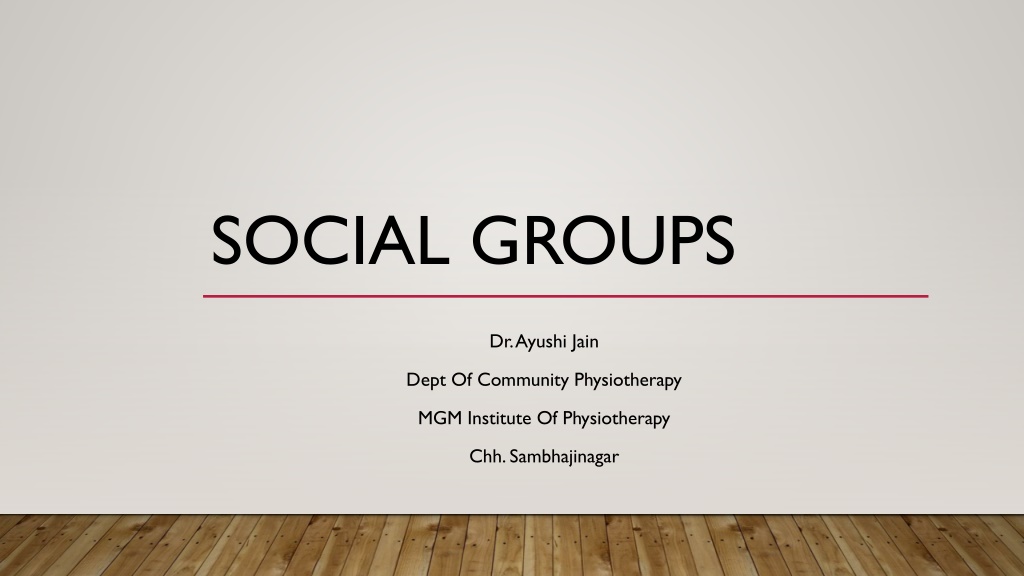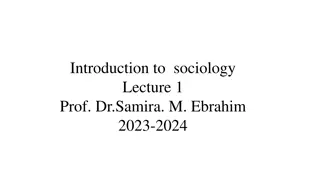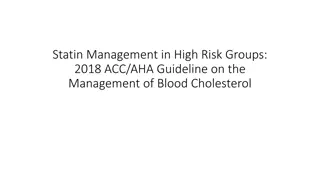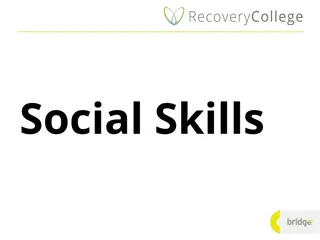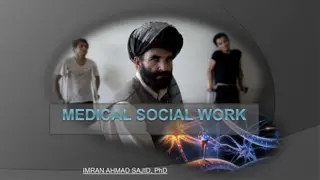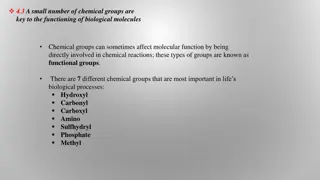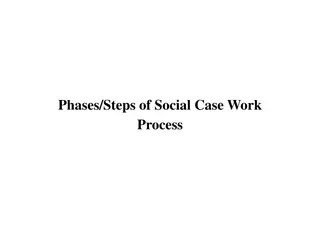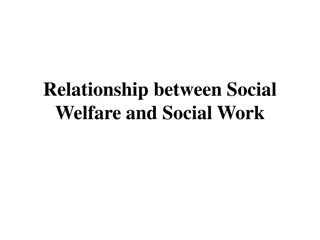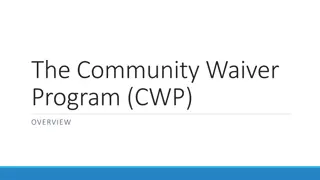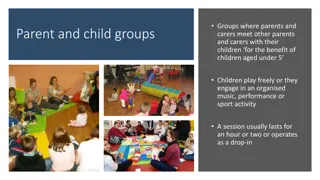SOCIAL GROUPS
Social groups are fundamental units where individuals interact to achieve common goals, form unity, and follow norms. They share values, cooperate, and have structured relationships. Good interpersonal relationships, collective identity, and group structure play key roles in shaping group dynamics.
Download Presentation

Please find below an Image/Link to download the presentation.
The content on the website is provided AS IS for your information and personal use only. It may not be sold, licensed, or shared on other websites without obtaining consent from the author.If you encounter any issues during the download, it is possible that the publisher has removed the file from their server.
You are allowed to download the files provided on this website for personal or commercial use, subject to the condition that they are used lawfully. All files are the property of their respective owners.
The content on the website is provided AS IS for your information and personal use only. It may not be sold, licensed, or shared on other websites without obtaining consent from the author.
E N D
Presentation Transcript
SOCIAL GROUPS Dr. Ayushi Jain Dept Of Community Physiotherapy MGM Institute Of Physiotherapy Chh. Sambhajinagar
INTRODUCTION Social group is a basic social unit when two or more persons interacting with each other, interrelationships are directed towards fulfillment of certain common goals or purposes. Inter-stimulation and response are the key factors in the process of social interaction.
DEFINITION A social group grows out of a situation which permits meaningful inter-stimulation and response between the individuals, focusing of attention on common situation or interest, the development of certain common drives, motivation or emotions.
CHARACTERISTICS OF GROUP LIFE The members of the group are related to each other and possess a sense of we feeling. Group involves a sense of unity The interests, ideals, values of the group members are common Similarity of behavior among the group members is observed There are certain norms, customs and procedures which are acceptable and everyone in the group to obey the norms, rules and regulations of their own group The members of the group are affected by its characteristics Homogeneous
Good interpersonal and interactional relationship Collective perception of their identity and unity Shares certain goals, values and beliefs Emerges social control over the behavior Cooperation Power relations Members behave in a natural and relaxed manner Membership is by voluntary, automatic in informal groups, with some purpose in formal groups Joining in a group may be motivated by a variety of personal needs Individuals who has similar values and beliefs will join together
GROUP STRUCTURE Is based on stability, and becomes structured. Group norms and standards, positions/authority, responsibilities are developed to regulate the actions of its group members. Group structure may be based on communication, as communication is essential in transforming information and coordinating the activities of individuals in groups.
participation Handling of conflict situation Job enrichment
CLASSIFICATION In group The members in the group will have we feeling and a common attitude and treats the group members as one. Eg: Family, group of friends. Based on ethnocentrism. People exhibit good behaviour with one to another. Out group People will develop a sort of hatred feeling on a particular group and treat the group completely away from them.
ROLE OF FORMAL GROUPS IN HEALTH OF THE INDIVIDUAL The formal group includes hospital, educational institutions, agencies which provide employment, occupational group, ESI schemes, Government schemes, political group and state.
At birth The health care professional provides necessary preventive and promotive measures for newborn care. Eg: Immunization services, feeding, bathing, rooming-in, socialisation of the child
Toddler, Preschool Cr che facility, play homes, balawadi, anganwadi teaches the child to share and learn the group responsibilities such as singing, playing, eating, studying, sleeping, rest pattern.
School Age Schoolmates help the child to develop good companionship, sharing, spending constructively the leisure time activities
Adolescents The teachers in the colleges act as a role model, counsel the child to keep in right track and good contacts, developing healthy competitive spirit, cooperation, shouldering responsibilities, encouraging individual projects and assignments; brings awareness on sex education.
Adulthood Healthy working environment, good companion, sound employer and employee relationships, promotes and protects the individual.
Old Age Providing shelter, healthy atmosphere, concern, assisting in daily living activities, nutritious food, arranging religious services and counselling services are some of the promotive measures.
ROLE OF FORMAL GROUP IN SICKNESS OF AN INDIVIDUAL In hospital setting, the health care professionals gather the data from client, his family, peer group, conducts physical examination, laboratory investigations and diagnose the problems of the client; prioritize the needs of clients, plans appropriate intervention measures, assists the clients in meeting their needs. Health care professionals will conduct free health camps and provide specialised services within the community at domiciliary level.
In rehabilitation settings, the intellectual levels of client will be assessed by health team members, according to the abilities and limitations skill oriented activities training is given to attain maximum potentiality of the individual. Certain insurance schemes like ESI benefits, medical and sickness benefits, health allowances, low cost nutritious food, safe drinking water, etc. are implemented to meet the needs of employee.
INFLUENCE OF INFORMAL GROUPS ON INDIVIDUAL HEALTH AND SICKNESS Family, peer group and playgroup are the components of the informal group
ROLE OF FAMILY Discussed in next lecture
Role of Playgroup Playmates are helpful in cultivation of healthy recreational habits, sharing and shouldering responsibilities, following norms, rules, regulations, ethical concept, development of good habits
Peer Group Individual behaviour in positive and negative manner. Eg: Reading habits, recreation habits, visiting worshipping places during leisure times avoiding eating food from unhygienic environment, etc. are some of the positive influences. The negative influences by the peer group are; cultivation of bad practices like smoking, alcoholism, drug abuse, gambling, internet browsing the unethical sites.
ROLE OF PRIMARY AND SECONDARY GROUP IN HOSPITALS AND REHABILITATION CENTRES Primary groups plays vital role in the individual s life. It is the nucleus of all social organizations. Group members have direct contact, closeness, help one another, provide companionship. Family, friends are the components of the primary group. The needs of the clients in health care settings can be described according to Maslow s theory of hierarchical needs. The needs like physiological, safety and security, love and belonging needs of the client are met by the primary group. The other needs like self-esteem, cognitive, aesthetic and self-actualisation needs will be met by the secondary group.
ROLE OF SECONDARY GROUP The health care professionals are considered as secondary group and play a vital role in fulfilling the specific needs of clients like esteem, cognitive, aesthetic and self-actualisation. In hospital setup, the health team members establish good interpersonal relationship with the client and develop rapport and win the confidence. The client will feel ease and comfortable and cooperate with the team members in planning, implementing and the remedial measures either in hospital and rehabilitation settings. The multidisciplinary team plays their respective roles in fulfilling the cognitive needs of the client by counselling and explaining about the prognosis of the disease
In rehabilitation settings the individual will be given sufficient training by the experts to the highest possible level of function ability. When the client is able to perform productive role, he actualises himself about his capacities, abilities and limitations and mould himself to accommodate to the changing situations
